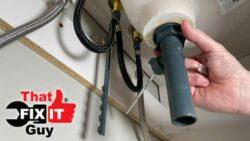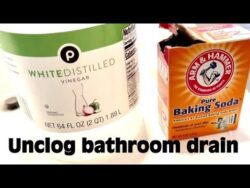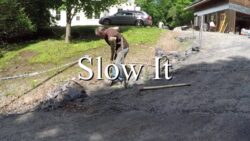In the midst of cold weather, it is crucial to protect the integrity and functionality of your pipes. This comprehensive guide provides essential insights on how to wrap your pipes effectively for cold weather conditions. By understanding the potential risks that freezing temperatures pose to your pipes and implementing the appropriate wrapping techniques, you can safeguard against unwanted damages and expensive repairs. With step-by-step instructions and valuable tips, this guide equips you with the necessary knowledge to preserve the reliability of your plumbing system during extreme cold snaps.
Selecting the Right Materials
Choosing Pipe Insulation
When it comes to wrapping your pipes for cold weather, selecting the right materials is essential to ensure effective insulation. Pipe insulation is available in various materials, including foam, rubber, and fiberglass. Foam insulation is commonly used due to its affordability, ease of installation, and excellent insulation properties. Rubber insulation is ideal for hot water pipes as it can withstand high temperatures. Fiberglass insulation is a good option for larger pipes and offers superior heat resistance.
Selecting Insulation Tape
In addition to pipe insulation, you will also need insulation tape to secure and seal the insulation. Insulation tape is typically made of a flexible material such as PVC or rubber and is designed to adhere to the surface of the insulation. It helps to create a tight seal and prevents moisture from seeping into the insulation. When selecting insulation tape, choose a product that is weather-resistant and suitable for the temperature range in your area.
Considerations for Outdoor Pipes
Outdoor pipes require special attention due to their exposure to cold air and potential freezing. When selecting materials for insulating outdoor pipes, opt for insulation that is specifically designed for outdoor use. These products are typically reinforced with a protective outer layer to withstand harsh weather conditions. Additionally, consider using heat tapes or heating cables for added protection against freezing temperatures.
Preparing the Pipes
Inspecting Pipes for Damage
Before wrapping your pipes, it is crucial to thoroughly inspect them for any signs of damage. Look for cracks, leaks, or weakened areas that may need immediate attention. Addressing any existing issues before insulation will prevent further damage and ensure the effectiveness of the insulation.
Cleaning and Drying
Clean the pipes thoroughly to remove any dirt, grease, or debris that may interfere with the adhesion of the insulation and tape. Use a damp cloth or mild cleaning solution to wipe the pipes clean. Once the pipes are clean, allow them to dry completely before proceeding with the insulation. Moisture can compromise the insulation’s effectiveness and lead to mold or mildew growth.
Measuring and Cutting Insulation
Accurate measurements are crucial to ensure proper coverage and a snug fit of the insulation. Use a measuring tape to measure the length and diameter of each pipe you intend to insulate. Add a few inches to the measurements to account for any curves or bends. Then, using a sharp utility knife or insulation cutter, carefully cut the insulation to the appropriate length. Ensure that the insulation fits securely around the pipe without any gaps or overlaps.
Wrapping Techniques
Starting at the Water Source
When wrapping your pipes, begin at the water source and work your way towards the end of the pipe. This ensures a continuous and uniform insulation coverage. Starting at the water source also allows you to secure the insulation firmly around the pipe fittings.
Insulating Plumbing Joints
Pay special attention to pipe joints and fittings as these areas are more susceptible to heat loss. To effectively insulate plumbing joints, cut the insulation into smaller pieces if needed and wrap them snugly around the fittings. Use insulation tape to secure the joints and create a tight seal.
Securely Fastening the Insulation
To prevent the insulation from slipping or coming loose, securely fasten it using insulation tape or zip ties. Wrap the tape tightly around the insulation, ensuring it adheres firmly to the pipe. If using zip ties, position them at regular intervals along the length of the insulation and tighten them securely. This will keep the insulation in place and maintain its effectiveness.
Wrapping Indoor Pipes
Wrapping Exposed Hot Water Pipes
Hot water pipes that are exposed in unheated areas, such as basements or crawl spaces, can lose heat quickly. Wrapping exposed hot water pipes with insulation is crucial to prevent heat loss and conserve energy. Measure the length and diameter of the exposed pipes and cut the insulation accordingly. Wrap the insulation tightly around the pipes, ensuring complete coverage. Pay extra attention to pipe joints and fittings to maintain uniform insulation.
Insulating Cold Water Pipes in Unheated Areas
Cold water pipes in unheated areas are at risk of freezing during cold weather. Insulating these pipes is essential to prevent freezing and potential bursts. Measure and cut the insulation to size and wrap it tightly around the cold water pipes. Ensure that there are no gaps or areas left exposed. Pay close attention to any valves or fittings and insulate them thoroughly to prevent heat loss.
Protecting Pipes in Crawl Spaces or Attics
Crawl spaces and attics are prone to extreme temperature fluctuations, making proper insulation of pipes in these areas crucial. Wrap the pipes in the crawl space or attic using insulation appropriate for the temperature conditions in your region. Ensure that all exposed areas of the pipes are covered, including joints and fittings. Securely fasten the insulation to prevent movement or slippage over time.
Insulating Outdoor Pipes
Insulating Pipes Exposed to Cold Air
Outdoor pipes exposed to cold air are particularly vulnerable to freezing. To effectively insulate these pipes, use insulation materials specifically designed for outdoor use. Wrap the insulation tightly around the pipes, ensuring complete coverage and no gaps. Pay extra attention to areas where the pipe enters the ground, as these are common freezing points. Consider using heat tapes or heating cables for added protection against freezing temperatures.
Wrapping Pipes in Exterior Walls
Pipes located in exterior walls may be subjected to colder temperatures, especially if the insulation within the walls is inadequate. Measure and cut the insulation to fit the length and diameter of the pipes. For pipes located within the wall cavity, use foam pipe sleeves to surround the pipes. Securely fasten the insulation using insulation tape or zip ties. This will help maintain a consistent temperature and prevent freezing.
Insulating Pipes in Sheds or Garages
Sheds and garages often have pipes that are exposed to fluctuating temperatures. To protect these pipes, insulation is essential. Measure and cut the insulation to the appropriate size and tightly wrap it around the pipes. Pay attention to any valves or fittings and ensure they are thoroughly insulated. In addition to insulation, consider using heating devices such as heat lamps or space heaters to provide additional warmth in these areas during extremely cold weather.
Dealing with Freezing Temperatures
Adding Heat Tape for Extra Protection
In extremely cold climates, adding heat tape to the pipes can provide an extra layer of protection against freezing. Heat tape is a flexible, electrical heating element that can be wrapped around the pipes. It automatically adjusts its heat output based on the ambient temperature, preventing the pipes from freezing. Follow the manufacturer’s instructions for installation and ensure that the heat tape is securely fastened to the pipes.
Using Pipe Heating Cables
Pipe heating cables are another option for preventing freezing in extremely cold temperatures. These cables generate controlled heat to keep the pipes warm. They are available in different lengths and can be easily wrapped around the pipes. Connect the pipe heating cables to a power source and adjust the settings according to the manufacturer’s instructions. Regularly inspect the cables for any signs of damage or malfunction.
Covering Outdoor Pipes with Insulated Caps
For additional protection against freezing temperatures, consider covering outdoor pipes with insulated caps. These caps are specifically designed to fit over the ends of the pipes, providing insulation and preventing cold air from entering. Ensure that the caps fit tightly and securely over the pipes. This will help maintain a more consistent temperature and minimize the risk of freezing.
Additional Tips
Allowing Faucets to Drip
In extremely cold weather, allowing faucets to drip can help prevent pipes from freezing. The continuous flow of water through the pipes reduces the likelihood of freezing by keeping the water moving. However, this technique should only be used as a temporary solution and is not a substitute for proper insulation.
Opening Cabinet Doors
For pipes located in kitchen or bathroom cabinets, opening the cabinet doors during cold weather can help circulate warm air around the pipes. This can prevent them from freezing. Remember to remove any hazardous substances from lower cabinets and keep them out of reach of children.
Maintaining a Consistent Indoor Temperature
Maintaining a consistent indoor temperature is essential to prevent pipes from freezing. Keep your thermostat at a steady temperature, especially during cold snaps. Avoid turning off the heating system entirely, even if you’re away from home. A consistent indoor temperature helps ensure that the pipes remain warm and minimizes the risk of freezing.
Monitoring and Maintenance
Checking for Any Leaks
Regularly check your pipes for any signs of leaks or damage. Inspect the insulation and tape for any wear and tear. Address any leaks or damage immediately to prevent water damage and ensure the continued effectiveness of the insulation. Prompt repairs and maintenance will help extend the lifespan of your pipe insulation.
Monitoring Weather Forecasts
Stay informed about the weather conditions in your area, especially during the winter months. Keep an eye on forecasts for extreme cold temperatures or freezing conditions. By staying ahead of any potential weather risks, you can take proactive measures to protect your pipes and prevent costly damage.
Inspecting and Replacing Damaged Insulation
Periodically inspect your pipe insulation for any signs of damage or deterioration. Over time, insulation can degrade or become less effective. If you notice any gaps, cracks, or other damage, replace the insulation promptly. Regular inspections and maintenance will ensure that your pipes remain adequately protected during cold weather.
Common Problems and Troubleshooting
Burst Pipes
Burst pipes are a common problem during freezing temperatures. If you discover a burst pipe, turn off the water supply immediately to prevent further damage. Drain the pipes by opening faucets and contact a professional plumber for repairs. Proper insulation and prevention techniques can help reduce the risk of burst pipes.
Frozen Pipes
If you suspect that your pipes may be frozen, turn off the water supply and open faucets to relieve pressure. Apply gentle heat to the frozen pipes using a hairdryer, space heater, or heat lamp. Do not use open flames or high heat that may damage the pipes. If you cannot thaw the pipes or if they have burst, contact a professional plumber for assistance.
Condensation Issues
Condensation can occur when there is a significant temperature difference between the water in the pipes and the surrounding air. Excessive condensation can lead to dripping pipes, mold growth, and water damage. To mitigate condensation, ensure proper insulation and maintain a consistent indoor temperature. If condensation persists, consider using dehumidifiers or ventilation systems to reduce moisture levels.
Ensuring proper insulation and protection for your pipes during cold weather is crucial to prevent costly water damage and maintain peace of mind. By selecting the right materials, properly preparing the pipes, and following the recommended wrapping techniques, you can effectively protect your plumbing system. Additionally, taking preventive measures and staying vigilant with monitoring and maintenance will help identify and address any potential issues before they escalate. By investing the time and effort into wrapping your pipes for cold weather, you can enjoy a winter season free from the stress and expense of frozen or burst pipes.





